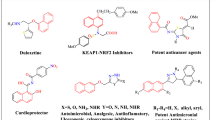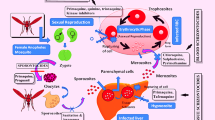Abstract
The search for new antimalarial agents is necessary as current drugs in the market have become vulnerable due to the emergence of resistant strains of Plasmodium falciparum (Pf). The enzyme dihydroorotate dehydrogenase (PfDHODH) is a validated target for development of antimalarial agents. PfDHODH is a crucial enzyme in the de novo pyrimidine biosynthesis pathway and is essential for the growth of the parasite. In this article, we report the design, synthesis and evaluation of benzanilides as inhibitors of PfDHODH. From the pool of molecules designed using molecular modeling techniques, candidates were shortlisted for further evaluation based on docking scores and 3D-QSAR studies. The activities of these shortlisted analogs were predicted from CoMFA and CoMSIA models. The most promising molecules were synthesized using solvent-free microwave-assisted synthesis and their structures characterized by spectroscopic techniques. The molecules were screened for in vitro antimalarial activity by the whole cell assay method. Two molecules viz. KMC-3 and KMC-15 were found to be active at 8.7 and 5.7 μM concentrations, respectively.








Similar content being viewed by others
References
Baldwin J, Farajallah AM, Malmquist NA, Rathod PK, Phillips MA (2002) Malarial dihydroorotate dehydrogenase. Substrate and inhibitor specificity. J Biol Chem 277:41827. doi:10.1074/jbc.M206854200
Baldwin J, Michnoff CH, Malmquist NA, White J, Roth MG, Rathod PK, Phillips MA (2005) High-throughput screening for potent and selective inhibitors of Plasmodium falciparum dihydroorotate dehydrogenase. J Biol Chem 280:21847. doi:10.1074/jbc.M501100200
Baumann P, Mandl-Weber S, Volkl A, Adam C, Bumeder I, Oduncu F, Schmidmaier R (2009) Dihydroorotate dehydrogenase inhibitor A771726 (leflunomide) induces apoptosis and diminishes proliferation of multiple myeloma cells. Mol Cancer Ther 8:366. doi:10.1158/1535-7163.MCT-08-0664
Becker K, Kirk K (2004) Of malaria, metabolism and membrane transport. TRENDS Parasitol 20:590. doi:10.1016/j.pt.2004.09.004
Boa AN, Canavan SP, Hirst PR, Ramsey C, Stead AM, McConkey GA (2005) Synthesis of brequinar analogue inhibitors of malaria parasite dihydroorotate dehydrogenase. Bioorg Med Chem 13:1945. doi:10.1016/j.bmc.2005.01.017
Breman JG (2001) The ears of the hippopotamus: manifestations, determinants, and estimates of the malaria burden. Am J Trop Med Hyg 64:1
Bush BL, Nachbar RB Jr (1993) Sample-distance partial least squares: PLS optimized for many variables, with application to CoMFA. J Comput Aided Mol Des 7:587
Chiang PK, Bujnicki JM, Su X, Lanar DE (2006) Malaria: therapy, genes and vaccines. Curr Mol Med 6:309
Cramer RD, Patterson DE, Bunce JD (1988) Comparative molecular field analysis (CoMFA). 1. Effect of shape on binding of steroids to carrier proteins. J Am Chem Soc 110:5959. doi:10.1021/ja00226a005
Cramer RD III, Patterson DE, Bunce JD (1989) Recent advances in comparative molecular field analysis (CoMFA). Prog Clin Biol Res 291:161
Davis JP, Cain GA, Pitts WJ, Magolda RL, Copeland RA (1996) The immunosuppressive metabolite of leflunomide is a potent inhibitor of human dihydroorotate dehydrogenase. Biochemistry 35:1270. doi:10.1021/bi952168g
Elkayam O, Yaron I, Shirazi I, Judovitch R, Caspi D, Yaron M (2003) Active leflunomide metabolite inhibits interleukin 1beta, tumour necrosis factor alpha, nitric oxide, and metalloproteinase-3 production in activated human synovial tissue cultures. Ann Rheum Dis 62:440
Fidock DA, Rosenthal PJ, Croft SL, Brun R, Nwaka S (2004) Antimalarial drug discovery: efficacy models for compound screening. Nat Rev Drug Discov 3:509. doi:10.1038/nrd1416
Freundlich JS, Yu M, Lucumi E, Kuo M, Tsai HC, Valderramos JC, Karagyozov L, Jacobs WR Jr, Schiehser GA, Fidock DA, Jacobus DP, Sacchettini JC (2006) Synthesis and biological activity of diaryl ether inhibitors of malarial enoyl acyl carrier protein reductase. Part 2: 2′-substituted triclosan derivatives. Bioorg Med Chem Lett 16:2163. doi:10.1016/j.bmcl.2006.01.051
Gramatica P (2007) Principles of QSAR models validation: internal and external. QSAR Comb Sci 26:694
Gujjar R, Marwaha A, El Mazouni F, White J, White KL, Creason S, Shackleford DM, Baldwin J, Charman WN, Buckner FS, Charman S, Rathod PK, Phillips MA (2009) Identification of a metabolically stable triazolopyrimidine-based dihydroorotate dehydrogenase inhibitor with antimalarial activity in mice. J Med Chem 52:1864. doi:10.1021/jm801343r
Hamilton LC, Vojnovic I, Warner TD (1999) A771726, the active metabolite of leflunomide, directly inhibits the activity of cyclo-oxygenase-2 in vitro and in vivo in a substrate-sensitive manner. Br J Pharmacol 127:1589. doi:10.1038/sj.bjp.0702708
Heikkila T, Thirumalairajan S, Davies M, Parsons MR, McConkey AG, Fishwick CW, Johnson AP (2006) The first de novo designed inhibitors of Plasmodium falciparum dihydroorotate dehydrogenase. Bioorg Med Chem Lett 16:88. doi:10.1016/j.bmcl.2005.09.045
Heikkila T, Ramsey C, Davies M, Galtier C, Stead AM, Johnson AP, Fishwick CW, Boa AN, McConkey GA (2007) Design and synthesis of potent inhibitors of the malaria parasite dihydroorotate dehydrogenase. J Med Chem 50:186. doi:10.1021/jm060687j
Hurt DE, Widom J, Clardy J (2006) Structure of Plasmodium falciparum dihydroorotate dehydrogenase with a bound inhibitor. Acta Crystallogr D 62:312. doi:10.1107/S0907444905042642
Kalra BS, Chawla S, Gupta P, Valecha N (2006) Screening of antimalarial drugs: an overview. Indian J Pharmacol 38:5
Klebe G (1998) Comparative molecular similarity indices analysis: CoMSIA. Perspect Drug Discov Des 12:87. doi:10.1023/A:1017025803403
Klebe G, Abraham U, Mietzner T (1994) Molecular similarity indices in a comparative analysis (CoMSIA) of drug molecules to correlate and predict their biological activity. J Med Chem 37:4130
Kobayashi Y, Ueyama S, Arai Y, Yoshida Y, Kaneda T, Sato T, Shin K, Kumegawa M, Hakeda Y (2004) The active metabolite of leflunomide, A771726, inhibits both the generation of and the bone-resorbing activity of osteoclasts by acting directly on cells of the osteoclast lineage. J Bone Miner Metab 22:318. doi:10.1007/s00774-003-0489-4
Li WD, Lin ZB (2002) Effects of leflunomide and its active metabolite on the production and mRNA expression of TNF-alpha in peritoneal macrophages and synovial cells with adjuvant arthritis in rats. Yao Xue Xue Bao 37:767
McRobert L, McConkey GA (2002) RNA interference (RNAi) inhibits growth of Plasmodium falciparum. Mol Biochem Parasitol 119:273. doi:S0166685101004297[pii]
Otsuka T, Koyama T, Ohtani R, Niiro H, Yoshizawa S, Harada M, Inokuma S (2008) Leflunomide-induced lung injury that developed after its withdrawal, coinciding with peripheral blood lymphocyte count decrease. Mod Rheumatol 18:96. doi:10.1007/s10165-007-0014-z
Perreux L, Loupy A, Delmotte M (2003) Microwave effects in solvent-free esters aminolysis. Tetrahedron 59:2185. doi:10.1016/S0040-4020(03)00151-0
Phillips MA, Gujjar R, Malmquist NA, White J, El Mazouni F, Baldwin J, Rathod PK (2008) Triazolopyrimidine-based dihydroorotate dehydrogenase inhibitors with potent and selective activity against the malaria parasite Plasmodium falciparum. J Med Chem 51:3649. doi:10.1021/jm8001026
Quashie NB, de Koning HP, Ranford-Cartwright LC (2006) An improved and highly sensitive microfluorimetric method for assessing susceptibility of Plasmodium falciparum to antimalarial drugs in vitro. Malar J 5:95. doi:10.1186/1475-2875-5-95
Richard D, Cramer RD III, Bunce JD, Patterson DE, Frank IE (1988) Crossvalidation, bootstrapping, and partial least squares compared with multiple regression in conventional QSAR studies. Quant. Struct. Act. Relat. 7:18
Ridley RG (2002) Medical need, scientific opportunity and the drive for antimalarial drugs. Nature 415:686. doi:10.1038/415686a
Shao J (1996) Bootstrap model selection. J Am Stat Assoc 91:655
Wold S, Johansson E, Cocchi M (1993) In: Kubinyi H (ed) 3D QSAR in drug design: theory, methods and applications. ESCOM Science Publishers, Leiden, p 523
Yao HW, Li J, Chen JQ, Xu SY (2004a) A 771726, the active metabolite of leflunomide, inhibits TNF-alpha and IL-1 from Kupffer cells. Inflammation 28:97
Yao HW, Li J, Chen JQ, Xu SY (2004b) The active metabolite of leflunomide A771726 inhibits proliferation and collagen synthesis of hepatic stellate cell. Zhejiang Xue Xue Bao Yi Xue Ban 33:515
Zhang X, Zhou H, Dong GF, Shi YZ (2005) An exploratory study on in vitro effects and mechanism of leflunomide on dendritic cells of systemic lupus erythematosus. Zhonghua Nei Ke Za Zhi 44:370
Zhang M, Hao N, Bian F (2008) The active metabolite of leflunomide A771726 inhibits corneal neovascularization. J Huazhong Univ Sci Technol Med Sci 28:364. doi:10.1007/s11596-008-0332-1
Acknowledgements
K. R. Desai is grateful to the All India Council for Technical Education (AICTE), New Delhi for support as JRF. The Department of Science and Technology (DST), New Delhi is thanked for facilities provided to the department through their FIST program (SR/FST/LSI-163/2003). We also would like to thank Ian Bathurst, Director, Drug Discovery and Technology, Medicines for Malaria Venture, Geneva, Switzerland and Sergio Wittlin, Head, Malaria Drug Discovery Group, Swiss Tropical Institute, Socinstrasse, Basel, Switzerland for antimalarial evaluation.
Author information
Authors and Affiliations
Corresponding author
Electronic supplementary material
Below is the link to the electronic supplementary material.
Rights and permissions
About this article
Cite this article
Desai, K.R., Shaikh, M.S. & Coutinho, E.C. Molecular modeling studies, synthesis and biological evaluation of derivatives of N-phenylbenzamide as Plasmodium falciparum dihydroorotate dehydrogenase (PfDHODH) inhibitors. Med Chem Res 20, 321–332 (2011). https://doi.org/10.1007/s00044-010-9323-4
Received:
Accepted:
Published:
Issue Date:
DOI: https://doi.org/10.1007/s00044-010-9323-4




